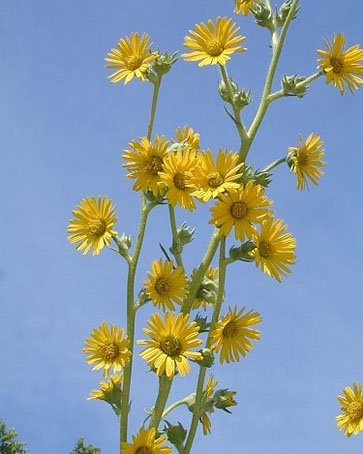Compass Plant
 Silphium laciniatum
Silphium laciniatum
A true icon of the prairies, these lovely plants are an incredible addition to your landscape.
Introduction
No those aren’t sunflowers, those are Compass Plants! The Compass Plant can be found at Gabis Arboretum in the Prairie as you walk the Bluebird trail or cut through the prairie on a prairie path.
Given moist, rich soils, mature compass stays low and compact until later in the season when it approaches bloom time, then the plants can reach upwards of 8 feet in height as the bloom reaches high.
It is quite a sight to see pollinators flit from flower to flower while birds, like Goldfinches, will perch upon the strong stems pecking for insects or seeds.
Life Cycle
Perennial
Sun Exposure
Full, Partial
Soil Moisture
Medium-Wet, Medium, Medium-Dry, Dry
Height
8 Feet
Bloom Time
June, July, August, September
Bloom Color
Yellow
About the Plant
The name Compass Plant comes from the observation that the leaves have a tendency to orient themselves on a north-south axis. While this certainly helped disoriented early Settlers find their way, the real reason behind this intriguing physiology is to maximize water use in the leaves as well as to increase CO2 gain for the plant. A
nother interesting aspect of Compass Plant biology is their life expectancy. Given the right conditions, individual plants have been known to live upwards of 100 years! Gardening with Compass Plant is gardening for the future.
Sadly, like all other species that live on the prairies, Compass Plants have taken a real hit from habitat destruction. Prairies are some of the most endangered habitats on the planet. Where there was once seemingly endless prairie, there are now only echoes of a lost world. As the great Aldo Leopold once said, “What a thousand acres of Silphiums looked like when they tickled the bellies of the buffalo is a question never again to be answered, and perhaps not even asked.”
Long-tongued bees are the primary pollinators of the flowers, including bumblebees, Miner bees, large Leaf-Cutting bees, and others. Short-tongued Halictine bees and Syrphid flies also visit the flowers, but they are less effective at pollination. Occasionally, Sulfur butterflies and Monarchs may visit the flowers for nectar.
Several species of insects are specialist feeders of Compass Plant. This includes the uncommon Okanagana balli (Prairie Cicada), whose grubs feed on the large taproot, while a Rynchites sp. (Silphium Beetle) and its larvae feed on the flower heads and stems. The larvae of Antistrophus rufus and Antistrophus minor (Gall Wasp spp.) feed within the stems, forming galls that are not visible from the outside. Nonetheless, they attract the hyperparasitic wasp Eurytoma lutea, whose larvae feed on these gall formers.
Similarly, the larvae of Mordellistena aethiops (Tumbling Flower Beetle sp.) feed within the stems, while the adults may eat the flowers. The oligolectic aphid Iowana frisoni sucks the juices from the flowering stems.